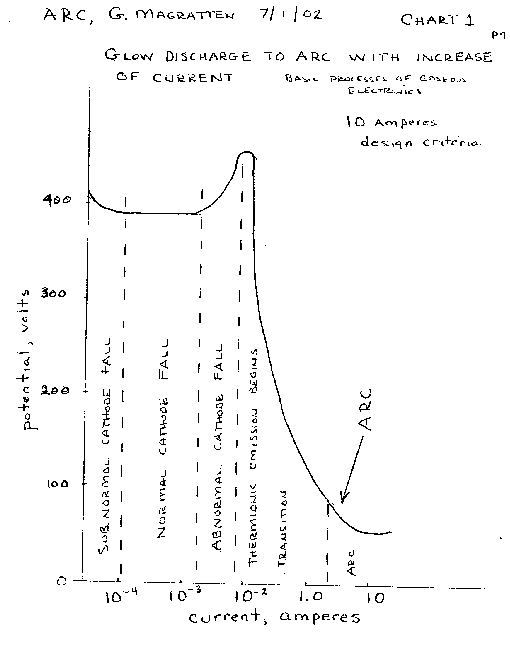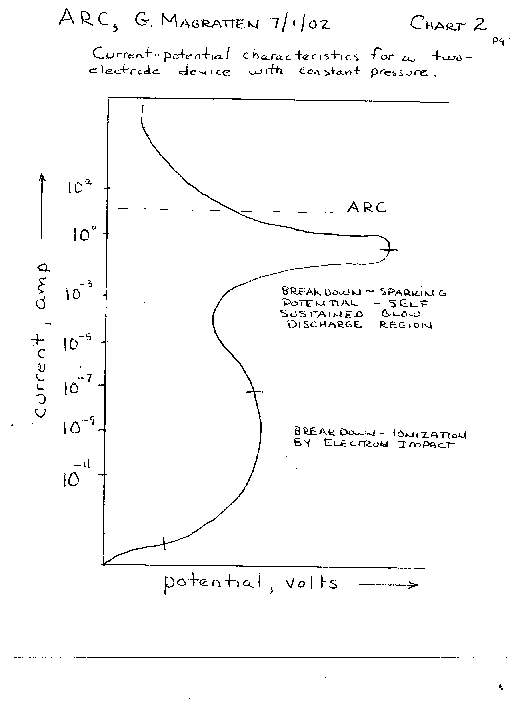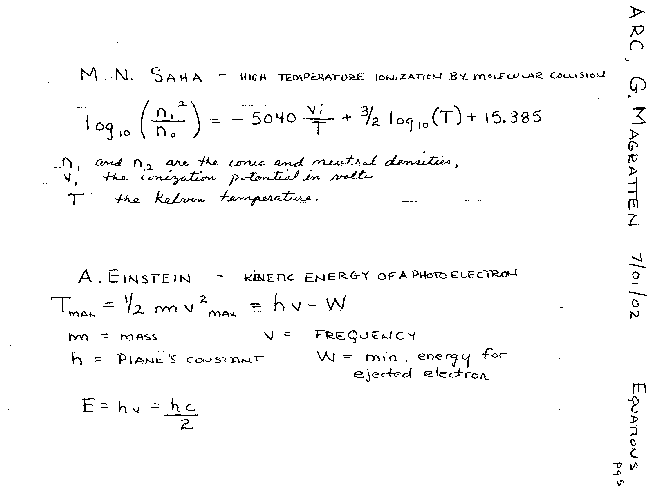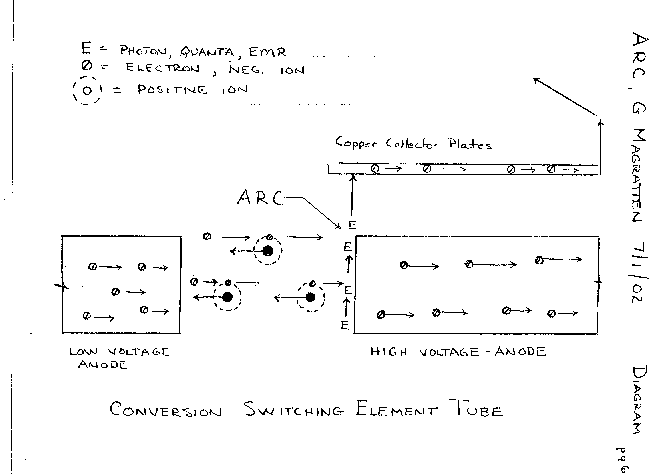

It is the purpose of this report to explain the use of 10 amps as being the necessary design criteria for the creation of an arc at the spark gap of the CSET of Gray's patent 4,595,975.
This report will give the theory and then the mathematical explanation.
The assumed duration of the arc is .00005 sec.. One ampere is one coulomb per see. 10 amps gives us .0005 coulombs of electricity per pulse.
The analysis of the ARC begins with its component parts; air molecules, positive and negative ions, electrons drawn from the LVA [low voltage anode], and the three thousand volt positive potential at the FIVA [ high voltage anode].
The principal constituents of the atmosphere are nitrogen (78%) and oxygen(21%). Electrons discharged from the LVA are drawn through the molecules of nitrogen and oxygen to the HVA by the 3,000 volt potential.
The collision of LVA electrons with the outer most shell electrons of the oxygen and nitrogen molecules causes the initial formation of positive and negative ions( free electrons). The ionization potential for air is 75 volts per .001 inch. This is the point at which air molecules breakdown to form ions thus forming a conductive pathway from the LVA to the HVA.
The spark gap of the CSET [ conversion switching element tube] should be .04 inches,(1/25th of an inch). Actual experiments show 3/32 to 3/16 of an inch. This may be because of the presents of humidity.
When the collision of electrons with air molecules occurs and electrons are removed from the outer orbit of the atoms positive ions are formed, The movement of positive ions colliding with other molecules of oxygen and nitrogen causes the formation of other positive and negative ions. In both oxygen and nitrogen the wavelenght of the outer most electrons is 4.85 Angstroms.
One angstrom equals 1 times I 0(-8) centimeters. The speed of light is 3. times 10 (8) meters/sec. The speed of light equals the wavelenght times the frequency. The frequency of the quanta of the eletromagnetic radiation emitted by the free electrons when absorbed by the JIVA should be 6.2 times 10(17/s). This is lower end X-rays.
It is common knowledge that electric arcs emit electromagnetic radiation in the frequency range of visible light, ultraviolet light and low end X-rays.
Bound electrons of the atoms that form the molecules of oxygen and nitrogen are knocked free [ unbound state] by the kenetic energy of the rapidly moving positive and negative ions.
One quanta of energy is absorbed by the bound electron in order to overcome the binding nuclear forces of gravitation and proton electromagnetic attraction. When the "free electron" returns to bound state in another atom, such as the HVA, one quanta of electromagnetic radiation is given off at 90 degrees to the direction of the current path
This EMR is absorbed by the copper collection grids of the CSET.
An ARC is a type of electrical conduction in gases characterized by high current and low potential drop.
To start an ARC on a cathode[ here the cathode and the LVA, low voltage anode are the same] there must be a higher initial voltage.
Ionizations of air molecules is caused primarily by the impact of electrons close to the LVA initially.
As the LVA temperature rises, the thermionic emission increases until the air molecules are sufficiently ionized to conduct electricity. At the point where the negative ions flow to the HVA and the positive ions flow to the LVA, the potential necessary to produce the discharge drops, a visible arc is formed. See

Chart #1.
In the ARC there is a positive ion current to the LVA. The electron current from the LVA to the HVA is larger( numerically) than the positive ion current.

This is because the electron discharge from the LVA is combined with the free electrons created by the formations of ions in the ARC pathway[ spark gap], each atom providing one positive ion and a negative ion. Please see Diagram 3.
It should be noted here that a refactory metal having a very high melting point provides better thermionic emission. That is why I used steel for the LVA and HVA. The high melting point is also helpful at the HVA where free electrons are absorbed and EMR is given off
The next CSET I build will employ stainless steel anodes.
The positive ions drawn to the LVA form a large space charge which help extract electrons from the LVA. The HVA draws in a large electron current. As the free electrons are absorbed by the HVA, quanta of EMR are given off by the electrons as they are added to the outer most shell of the atoms of the conductor. This is known as electron affinity.
The air molecules between the LVA and the HVA are ionized predominately by a temperature effect. Energy can be imparted to air molecules in the form of atomic and molecular excitation.
With many intermolecular collisions this energy is readily transferred to the thermal energy of the air molecules. Thus a high temperature may be achieved and ionization occurs by intermolecular collisions.
This is expressed quantitatively by the equation derived by M.N. Saha. Please see Equation at the end of the report.
After the Arc is formed the voltage necessary to maintain the ARC is less than the ionization potential of the air molecules. The heat from the ARC increases the temperature of the LVA.
This increases the thermionic emission from the LVA. The magnetic field provided by the positive ions surrounding the LVA lowers the barrier for electron emission. Both of these effects result in increased electron emission from the LVA. See Chart 2.
Quanta of electromagnetic radiation are released by electron affinity as free electrons strike the HVA and are absorbed by the conductor's atoms with the force of the HVA's 3,000 volt positive potential.
The release of EMR has two effects. First, if the photons [photons, quanta, electromagnetic radiation, EMR and Radiant Event, all refer to the same thing] , strike the copper collector plates of the CSET, their energy is absorbed by the electrons of the copper atoms.
Secondly, if the photons strike an air molecule, ionization may result as the electron in the outer most energy shell absorbes the kenetic energy of the photon giving the electron enough energy to overcome the binding forces resulting in futher ion production.
These photons have a wavelenght in the visible light ultraviolet, and X-ray region of the electromagnetic spectrum.
Thus there appears to be three related methods of air molecule ionization; electron impact, positive ion impact, and photon impact.
If the free electrons and positive ions gain enough energy in a high voltage field to collide with an atomic or molecular electron the result is an ion pair, a positive ion and a new free electron.

Cumulative [total] ionization is an extention of ionization by impact.
IF THE PROCESS IS REPEATED OVER AN]) OVER, THE RESULT IS CALLED
AVALANCHE, AND THE CUMULATIVE IONIZATION IS REFERED TO AS
BREAKDOWN OR THE IONIZATION POTENTIAL OF THE AIR MOLECULES. THUS THE FREE ELECTRONS AND PHOTONS ARE ABSORBED BY THE CIRCUIT RESULTING IN A GAIN OF POWER.
The free electrons from the ionized air molecules are absorbed by the HVA in the form of a current. The photons are absorbed by the collector plates of the CSET to form a voltage. The increase in voltage and current form a GAIN in POWER for the circuit.

Part one of this article